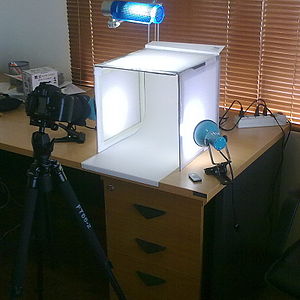Diffuser (optics)
In
Types
Perfect reflecting diffuser
A perfect (reflecting) diffuser (PRD) is a theoretical perfectly white surface with Lambertian reflectance (its brightness appears the same from any angle of view). It does not absorb light, giving back 100% of the light it receives.[1] Reflective diffusers can be easily characterised by scatterometers.[2]
Diffractive diffuser/homogenizer
A diffractive diffuser is a kind of
Applications

Diffusion filters may be used to diffuse the light falling on the subject, or placed between the camera and the subject for a hazy effect.
Lighting diffusers, transmitting and reflecting
A flash diffuser (also called a speedlight diffuser, or shoot-through diffuser) spreads the light from the
Reflecting diffusers for photography are generally called "reflectors".
In effect, the light will not come from one concentrated source (like a
-
Diffuser on a camera flash. Made from a sheet of paper, a rubber band, and two staples.
-
A more formal diffuser filter over a camera flash, flanked by reflectors
-
Flash diffuser to be mounted on a camera
-
Softbox diffuser; a larger area spreads the light more
-
A lighting technician holds a reflector to diffuse the light falling on a politician
-
A home-made lightbox, designed to produce images with diffuse lighting from all angles
-
Lightbox photography
-
Both transmitting (softbox) and reflecting diffusors are used to light wagashi for a television program
-
Studio lights, one white, two metallized
-
Theatrical colour magazine or boomerang. Placed in front of a stage light, it gives quick changes in lighting gel, including a diffusion filter
-
Shōji
Objective-lens filters
"Diffusion filter" may also refer to a
Diffuser materials
Silk sheets can also be used as diffusers, and in fact were until the invention of translucent plastics. "Opal" is a common translucent or
Recently, photopolymers have been used for making holographic diffusers. Photopolymers offer better performance than other materials and have a large viewing angle. Also, the process of synthesizing photopolymers is much simpler.
See also
- Beam homogenizer
- Diffuse reflection
- Integrating sphere
- Photon diffusion
- Beauty dish
- Reflector (photography)
- Softbox
- Soft focus
References
- ISBN 0-470-01216-1.
- ^ a b "Page Title". www.zebraoptical.com.
- ^ Walecki, Wojciech, and Peter Walecki. "Robust diffuser and roughness metrology tool for LED manufacturing." SPIE OPTO. International Society for Optics and Photonics, 2015.











